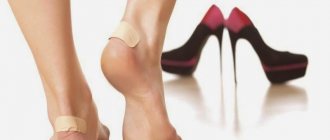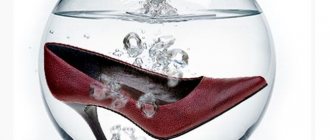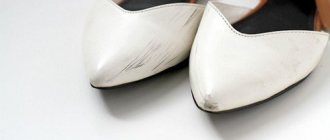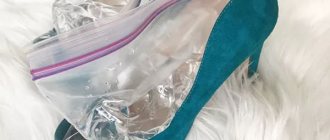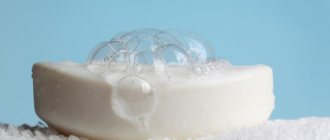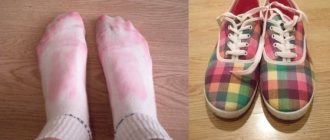Angelina
Last fall, when I took my winter boots out of the box, I noticed that the leather had become tough. I had to buy expensive products and treat it, but still a crack appeared in one place. In the spring, when it was time to put my shoes into storage, I read the recommendations of manufacturers and specialists. I'll tell you how to cook and how to lubricate shoes for storage.
Proper preparation for storage extends the life of shoes. The skin will always be soft and will not crack from drying out.
How to prepare products
Before putting your shoes away for seasonal storage, follow these simple steps:
- Clean the surface from dirt . The cleaning method depends on the type of product. For example, leather is cleaned with a brush, nubuck is cleaned with a special device, and care for textile shoes most often involves proper washing. If you don’t know how to clean the surface, use warm water and a damp cloth.
- Dry your shoes. If you put in damp steam, within a month the surface may become moldy or even begin to rot. All types of materials deteriorate from dampness. Drying is carried out under natural conditions at room temperature. Do not place products in the sun or near heating devices.
- Repair the products if necessary. Before storing your shoes, fix any problems - replace worn heels or jammed zippers. This is much more convenient than getting a pair when cold weather sets in and discovering that it needs to be repaired and remains frozen for a few more days.
- Use filler . Crumpled paper or special lasts will maintain the shape of the shoes and prevent their deformation. Fill it carefully so as not to break the shape.
- Don't throw away boxes . These are the best places to pair up. This creates optimal storage conditions. In addition, it is very easy to find the products you need afterwards.
We figured out how to properly store shoes at home. Now let's look at how to process it.
How to care for shoes after the season ends
Before sending sandals and shoes into hibernation, arrange an inspection. Lay out your entire collection in the hallway, examine every pair down to the last slipper. Throw away the old and unusable ones, set aside those that are time to be repaired, and take them for repairs without delay. Even if you don’t put away all-season shoes: sneakers or replaceable ballet flats, an extra inspection and cleaning won’t harm them.
* Wash and tidy your shoes. Wash anything that can be machine washed with your old towels. It is better to use gel and stain removers rather than powder. Remove the laces and insoles in advance - it is better to wash them separately using laundry soap and stain removers.
* Leather shoes are popular, but rather difficult to care for. Gently wash your pair with a damp sponge and a light soap solution, making sure that the water does not saturate the leather, treating only the surface. Wipe the soles and dry them thoroughly - but away from the battery.
Lubricate the surface and seams with wax or natural cream before storing. If the shoes are faded or worn out, treat them with colored cream. To maintain their shape, stuff your shoes or boots with newspaper or insert special shoe trees for storage.
* Clean shoes made of nubuck, suede and velor with a dry brush and wipe the soles. For each type of such shoes there are special rubber or rubber brushes, brushes made of medium-hard bristles. Saturate the surface with a special spray, and if stains appear, treat them with a cleaning spray, then hold the area with the stain over steam and brush again.
To remove stains from velor shoes, rub them with a special eraser for velor, then brush with a rubber brush. Before packing such shoes, it is also better to install pads and stuff them with newspapers or paper towels.
* Wipe patent leather shoes with a soft velvety cloth, and if necessary, treat them with a damp microfiber cloth; a mild soap solution will do. Treat with a special care product or glycerin. Scratches and burrs can be carefully treated with clear nail polish.
How to clean white sneakers
White sneakers can be especially “tired” after an active season. To bring them back to life, first remove dirt and dust with a dry brush. If simple stains appear on your sneakers, and you don’t have a special care product at hand, you can try budget homemade options: a regular white eraser, toothpaste, soaked baking soda, lemon juice, laundry soap, micellar water.
The sole can be treated with nail polish remover or Pemolux. For fabric sneakers, oxygen-based bleaches and stain removers (labeled Oxi) are suitable.
Take your product and rub it into the dirty areas of your sneakers with a toothbrush. Leave for 10-15 minutes and rinse gently with a napkin or sponge. If this does not help, put the sneakers in water with bleach and stain remover for 2-3 hours, then brush the surface with toothpaste or soda and rinse thoroughly. If you are confident in the manufacturer, wash your sneakers; to do this, place them in a pillowcase or wash them with T-shirts and towels in the “Sports Shoes” or “Hand Wash” mode, it is better to turn off spinning and drying. Before washing, soak your shoes for a couple of hours in warm water with stain remover. For washing, use bleaching gel or stain remover.
It is better to dry sneakers after washing in the open air, but not on a radiator. Stuff paper towels inside to absorb water and shape the shoes. It is better to store them in a separate linen bag or in wrapping paper.
Treatment with protective compounds
In summer, the shoe material can dry out, become hard, rough, and crack.
Natural insulation is often attacked by moths. To keep shoes looking fresh after seasonal storage, you need to:
- Treat the outside with a care product. Genuine leather and leatherette are rubbed with shoe polish. For suede and nubuck, aerosol products are used. Treatment prevents moisture loss and roughening.
- Use a moth repellent: special balls, sochettes, sprays. Modern drugs are odorless. For example, “Anti moth” or “Armol Expert” aerosols have virtually no odor, and at the same time repel moths for 5 months. You can process the boxes in which shoes will be stored.
Advice. If your shoes have lost their color, it's time to touch them up. You can use the services of a repair shop or purchase a can of shoe paint and perform the procedure yourself; small scratches can be painted over with a felt-tip pen.
How to store shoes in a closet
A sliding wardrobe is an indispensable piece of furniture for a large number of things. In such a closet you can place both last year’s and the new collection of the whole family:
- Textile organizers are attached to the outside and inside of the cabinet. Such options are more suitable for storing holiday, seasonal shoes, slippers, and for “today’s” shoes it is better to leave a place in the hallway.
- On the lower modules you can place special shoe hangers for boots, and on regular hangers you can attach sneakers, sandals, and clogs using clothespins.
- For winter shoes, it is better to use lower pipe modules, securing boots and boots at an angle. This will still leave enough space for outerwear.
Creative ideas for organizing space will help you make an interesting design move. And practical devices will simplify life and add new notes to the interior.
Insects
Moths are a classic problem in many apartments and houses. She may be attracted by the coat, or maybe by the fur trim on her boots. Ventilation in boxes and storage areas will solve the problem with moths. And for reliability, you can put a cotton pad with two drops of lavender oil in each box. In addition, stores sell special sprays, tablets or plates that protect against moths.
The listed rules for the care and storage of shoes may seem complicated. But if you regularly clean, air and dry your shoes, there will be no problems before storing them. And by next season you won’t have to run around the shops looking for a good pair for the winter.
Spring mood. How to choose a scarf for a trench coat or raincoat
How to determine the fullness of your feet for shoes
Marking
If the shoes are in opaque boxes, then they should be labeled. This is easy to do by printing out a photo of the couple and sticking it on the box. But this is not always possible. You can simply sign, for example, “gold sandals with a buckle.”
And finally, we would like to say that you should not store boxes of shoes in places of high humidity, that is, on the balcony or in the basement. The garage is also not the best place for storage. It is optimal if there is a separate closet or niche in the closet for shoes. Also, if you have niches under a sofa or bed, you can also put shoes there.
Storing rubber shoes
Rubber shoes seem to be the most unpretentious of the entire shoe family. But this is far from true. It's all about the ability of rubber (the material from which rubber is made) to crack in the sun. High humidity also harms rubber products. Staying in damp for a long time causes the rubber item to lose its elasticity and become “stiff.”
Rubber shoes should be stored after they have completely dried, in a cardboard box in a dark, dry place.
Rubber shoes with high tops (“wading” boots) should be stored exclusively hanging in a dark place with a normal level of humidity and good ventilation.
Leather shoe care products
After the drying process is completed, the leather surface must be treated with a special cream or spray and polished. The most popular care products for leather shoes are the shoe polish group, which contain the following components:
- wax;
- paraffin;
- solvents;
- dyes;
- ceresin
Such creams give the skin plasticity, improve its appearance, and enhance its water-repellent properties. Experts recommend applying this cream with a brush and leaving it to absorb for a while. After two to three hours, you can remove the excess and polish the surface of the shoe with velvet cloth.
In addition, you can use folk remedies. It is recommended to treat new shoes or boots made of leather with lard before the first wear. This will significantly extend the life of the pair. Flaxseed oil has good water-repellent properties. Two or three treatments per season are sufficient. And then the skin will not get wet through.
The material of the product dictates the storage conditions
When using bulky boxes or organizers to place shoes, there are a few rules to remember.
- Suede does not tolerate any proximity, so it is better to allocate a personal box for shoes made of this soft and capricious material.
- Fabric shoes, since they easily absorb moisture, are usually stored separately from leather ones.
- Leather products do not like elevated temperatures, so they require periodic ventilation.
Shoes will be more preserved if you put paper or fabric between shoes of even the same pair.
Also, do not neglect periodically checking the storage for the presence of moths.
Maintenance during use: cleaning and drying
After the next “outing”, leather shoes must be cleaned from dust and dirt. This is especially true for periods when it is damp and slushy outside. Dirt should not be removed with a stream from a hot tap, but with a warm, damp cloth made of soft natural material (for example, flannel or calico) or a sponge. Moreover, this applies not only to the top of the shoe, but also to the sole.
After cleaning the product from dirt, wipe the leather surface dry with a soft cloth and leave to dry. In no case should you place leather products on a radiator or heater or use electric dryers to artificially speed up the process.
During wearing, use disinfectants, especially when caring for winter shoes, shoes or boots. Then unpleasant odors will never cause trouble, and the fur inside the pair will retain its quality and appearance for a long time.
Caring for leather shoes in winter differs in that white salt stains appear on the products. Such stains should be removed with a soft cloth moistened with suntan lotion or body milk. Rub strong and prominent marks or stains with juice squeezed from onions, let them dry and the stains will disappear.
To ensure that leather shoes retain their shape, it is better to put spacers inside when drying or insert crumpled dry newspapers. If the couple gets very wet, the newspapers need to be changed several times. How to quickly and safely organize drying, read the article “How to quickly dry shoes.”
General cleaning
It is not enough to simply wipe your shoes with a cloth and put them in the closet. There are 5-7 long months of heat and active insect life ahead. To prevent your favorite boots from deteriorating during this period, you must first clean them well.
Dirt on boots and traces of sweat on insulation are food for bacteria and fungus. In addition, “odorous” pollution attracts insects.
Therefore, you need to carefully clean your favorite pair before storing:
- It is necessary to wash the inside of the boots. To do this, use liquid detergents for wool. They rinse well and do not clog the material like powders and soaps.
- The insole should be properly removed before the procedure. It is replaced with a new one or washed separately.
- The detergent is diluted according to the instructions. The temperature of the soap solution should not exceed 30 degrees.
- Next, the solution is poured into the shoes and left for 5 minutes.
- They go through the inside of the boots with a brush.
- Rinse with clean water and dry.
- The outside of the shoes is cleaned with soft brushes, and suede and nubuck are cleaned with special cleaning foam.
Winter shoes, especially leather and suede, should not be in contact with water for too long. You need to wash them in 15-30 minutes.
Advice. If the inside of the boots is relatively clean, you can not wash them inside, but vacuum them and treat them with an antiseptic shoe spray.
Organizers
shoe storage organizer The fabric walls allow air to pass freely, which ensures its free circulation, while protecting it from dust.
Disadvantages - it will not protect against spilled tea or other liquid, and it is not worth storing expensive shoes in it, since the soft fabric walls will not protect against mechanical damage and deformation.
Main characteristics, pros and cons of genuine leather
The basis of the skin, its building block, is the natural protein collagen . Thanks to its properties and modern technologies for processing the source material, leather items have a durable, elastic, soft-to-touch texture. Collagen fibers connected in bundles form a porous cover that is highly permeable to air and absorbs vaporous emissions.
From a hygienic point of view, these characteristics indicate the undoubted advantages of leather items . They cause pleasant tactile sensations, retain heat well, hygroscopic properties allow you to regulate sweating processes, and through pores ensure free air circulation.
But with improper care, the above advantages can easily turn into disadvantages . After all, natural protein needs constant softening and moisturizing; it is unstable to mechanical damage, so scratches and creases easily appear on it. When external conditions change, for example, an increase in outside temperature, drying out, the mechanism of protein denaturation is triggered, i.e., its modification. The most striking manifestation of this process is the loss of elasticity of the product.
How to store shoes if you have little space
Small spaces hide a lot of possibilities. I want every couple to find a place, and there is complete order in the house. Even in a small room you can add the required number of pairs:
- Open and closed chest of drawers. The first ones simplify the search - everything is immediately visible. For closed models, it is worth taking small photos of the boots, attaching the photo with double-sided tape.
- You can use a clothes hanger to store shoes in the hallway. This is a suitable way to organize your daily used models and save space.
- There are separate gadgets for boots and ankle boots that are difficult to fit in a drawer or chest of drawers. This can be a hanger on a long metal pipe, where each pair is attached to each other using a magnetic clothespin.
Cloth
Outerwear should be carefully inspected after the end of the season, especially the cuffs and hem. Hem any loose seams, clean small stains with a mixture of chalk and ammonia. If the dirt is serious, and the skin is shiny in places, it is better to take the items to dry cleaning.
After cleaning, air your wardrobe items in the fresh air for several days, but not in direct sunlight. Coats and jackets with fur lining should be protected from moths. To do this, place bags of repellents in your pockets, hood, and cuff cuffs. Now they produce special aromatic sachets.
Bags of lavender, geranium leaves or pine nuts will do the job well.
The hanger also needs to be chosen correctly. It should be durable, with sufficient size and shoulder width so that the sleeves do not sag, and the clothing does not deform or tear under its own weight.
The product, straightened and buttoned up, is placed in a spacious cover made of non-woven material or canvas, which allows air to pass through well, while trapping dust, light and foreign odors. For jackets and coats, choose short cases up to 100 cm; for coats and sheepskin coats, choose voluminous hanging trunks up to 140 cm.
